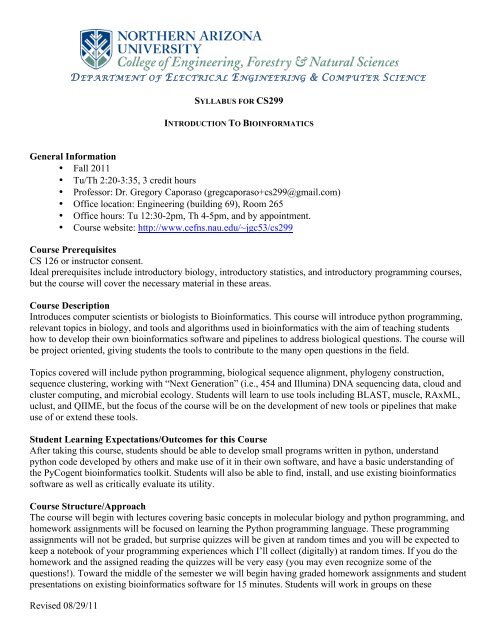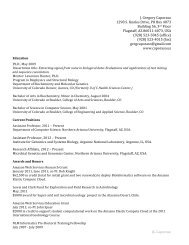Course syllabus - J. Gregory Caporaso
Course syllabus - J. Gregory Caporaso
Course syllabus - J. Gregory Caporaso
You also want an ePaper? Increase the reach of your titles
YUMPU automatically turns print PDFs into web optimized ePapers that Google loves.
Revised 08/29/11<br />
DEPARTMENT OF ELECTRICAL ENGINEERING & COMPUTER SCIENCE<br />
SYLLABUS FOR CS299<br />
INTRODUCTION TO BIOINFORMATICS<br />
General Information<br />
• Fall 2011<br />
• Tu/Th 2:20-3:35, 3 credit hours<br />
• Professor: Dr. <strong>Gregory</strong> <strong>Caporaso</strong> (gregcaporaso+cs299@gmail.com)<br />
• Office location: Engineering (building 69), Room 265<br />
• Office hours: Tu 12:30-2pm, Th 4-5pm, and by appointment.<br />
• <strong>Course</strong> website: http://www.cefns.nau.edu/~jgc53/cs299<br />
<strong>Course</strong> Prerequisites<br />
CS 126 or instructor consent.<br />
Ideal prerequisites include introductory biology, introductory statistics, and introductory programming courses,<br />
but the course will cover the necessary material in these areas.<br />
<strong>Course</strong> Description<br />
Introduces computer scientists or biologists to Bioinformatics. This course will introduce python programming,<br />
relevant topics in biology, and tools and algorithms used in bioinformatics with the aim of teaching students<br />
how to develop their own bioinformatics software and pipelines to address biological questions. The course will<br />
be project oriented, giving students the tools to contribute to the many open questions in the field.<br />
Topics covered will include python programming, biological sequence alignment, phylogeny construction,<br />
sequence clustering, working with “Next Generation” (i.e., 454 and Illumina) DNA sequencing data, cloud and<br />
cluster computing, and microbial ecology. Students will learn to use tools including BLAST, muscle, RAxML,<br />
uclust, and QIIME, but the focus of the course will be on the development of new tools or pipelines that make<br />
use of or extend these tools.<br />
Student Learning Expectations/Outcomes for this <strong>Course</strong><br />
After taking this course, students should be able to develop small programs written in python, understand<br />
python code developed by others and make use of it in their own software, and have a basic understanding of<br />
the PyCogent bioinformatics toolkit. Students will also be able to find, install, and use existing bioinformatics<br />
software as well as critically evaluate its utility.<br />
<strong>Course</strong> Structure/Approach<br />
The course will begin with lectures covering basic concepts in molecular biology and python programming, and<br />
homework assignments will be focused on learning the Python programming language. These programming<br />
assignments will not be graded, but surprise quizzes will be given at random times and you will be expected to<br />
keep a notebook of your programming experiences which I’ll collect (digitally) at random times. If you do the<br />
homework and the assigned reading the quizzes will be very easy (you may even recognize some of the<br />
questions!). Toward the middle of the semester we will begin having graded homework assignments and student<br />
presentations on existing bioinformatics software for 15 minutes. Students will work in groups on these
projects, with groups chosen by the instructor. Graded homework assignments will be done independently, and<br />
will primarily be programming tasks. Two exams will be given over the course of the semester: a midterm and a<br />
final exam.<br />
Homework assignments and reading should be completed by the due date provided on the course schedule.<br />
Quizzing on the assignments due the same day is fair game.<br />
Come to office hours! This course covers a lot of diverse material, and office hours are your chance to interact<br />
with me directly to ensure that you understand the concepts being covered in class. Coming to office hours is<br />
also a great way to boost your class participation score.<br />
Textbook and Required Materials<br />
The Processes of Life (ISBN: 978-0262013055)<br />
This books covers basic biological concepts that we’ll hit during the course. You can find chapter 1 online for<br />
free so you can keep up on the reading if you’re waiting for a hard copy of the text. Chapter 1 is available here:<br />
http://mitpress.mit.edu/books/chapters/0262013053chap1.pdf.<br />
Learn Python the Hard Way, 2nd edition (http://learnpythonthehardway.org/)<br />
We will use this book extensively for learning python. There is a free html version, as well as a PDF ($2.99),<br />
and a hard copy ($15.99 paperback; $60 hardcover). If you choose to purchase this book, be sure to get the<br />
second edition.<br />
Recommended References<br />
Molecular Biology of the Cell (ISBN: 978-0815341055)<br />
This book is an extremely useful reference. If you're planning to take additional biology classes, or if you'll<br />
continue to pursue Bioinformatics, a copy of this book will be invaluable. We may reference some sections of<br />
this text that are available for free online. There is also an e-book available which you can buy, rent, or buy by<br />
the chapter – you can get information here: http://store.vitalsource.com/show/9781136844423.<br />
Links to other useful resources are available here:<br />
http://www.cefns.nau.edu/~jgc53/cs299/books_and_links.html<br />
<strong>Course</strong> Outline<br />
http://bit.ly/mOASpI<br />
A tentative course outline is provided at the link above. It is very likely that this outline will change over the<br />
course of the semester as we identify certain areas that we’ll need to spend additional time on – for that reason<br />
the outline is provided in a dynamic format. The spreadsheet at the above link will always be the definitive<br />
source for the outline, reading assignments, and homework assignments.<br />
Homework assignments listed as “LPTHW exercises …” refer to exercises in the Learning Python the Hard<br />
Way text. You can find these at this link: http://learnpythonthehardway.org/book/. Readings listed as<br />
“Hunter…” refer to sections in The Processes of Life.<br />
Assessment of Student Learning Outcomes<br />
• You will be assessed primarily thorough graded material (see Grading System). A small portion of your<br />
assessment will be based on participation. This allows me to determine if you understand the material<br />
well enough to ask questions and engage in discussion in class and in office hours.<br />
• I will strive to return all graded materials within seven days, and hopefully sooner. Under some<br />
circumstances I may need a little more time. Check with me at any time during the semester on your<br />
current participation score.<br />
Revised 08/29/11
Grading System<br />
• 5% Participation<br />
• 20% Surprise quizzes and programming notebook; lowest quiz score will be dropped<br />
• 5% Application presentation<br />
• 20% Graded homeworks; lowest homework score will be dropped<br />
• 25% Midterm exam<br />
• 25% Final exam<br />
Grading Scale<br />
A: 90-100<br />
B: 80-90<br />
C: 70-80<br />
D: 60-70<br />
F: 0-59<br />
<strong>Course</strong> Policy<br />
• If you have a legitimate reason why you cannot make one of the exam times or why you won’t be able<br />
to complete an assignment by the due date, talk with me early on and something can be arranged.<br />
Students who do not show up for exams without making prior arrangements will get a zero.<br />
• Students are not graded on attendance, but there will be no make-ups of surprise quizzes so it is highly<br />
recommended that you plan to attend all lectures. If you have to miss a lecture and there is a quiz that<br />
day, it will count as your dropped quiz score.<br />
• Plagiarism and cheating will not be tolerated. Any students found guilty of either will receive a failing<br />
grade in the class. We will discuss what counts as plagiarism of software on the first day of the course.<br />
• No computers, cell phones, headphones, books or papers may be used during quizzes or exams. If a<br />
student is observed looking at or touching any of these items during a quiz or exam it will be considered<br />
cheating – this includes checking to see who just texted you! To be safe, I recommend turning off cell<br />
phones during exams.<br />
• Computers may be used for course-related work during the class such note taking or working along with<br />
programming examples that are being done on the overhead. You may not however use computers for<br />
non-course-related work such as checking e-mail or Facebook. If I notice you doing this I will document<br />
it and count it against your participation grade in the course.<br />
University Policies<br />
The Safe Environment, Students with Disabilities, Institutional Review Board, Academic Integrity, Academic<br />
Contact Hour, Classroom Management and Professional Ethics and Code of Conduct policies are available at<br />
http://www4.nau.edu/avpaa/policy1.html. Students are responsible for reviewing and understanding these<br />
policies.<br />
Revised 08/29/11



